ADEPT | Gagauzia 2016 | Presidential 2016 | Elections 2015 | Bashkan 2015 | Gagauzia 2012 | Political Parties
BOP at the end and beginning of governing…
Perceptions vs. realities
The accession of the Alliance for European Integration (AIE) to the governing in 2009 to replace the Party of Communists of the Republic of Moldova (PCRM) was a turning point in the social-political life in Moldova. In this respect, sociological measurements are required to assess how people realise this phenomenon and understand the change. In this light, the last two measurements by the Barometer of Public Opinion (BOP) poll commissioned by the Institute for Public Policy (IPP) have a special meaning, particularly because the PCRM wants to take revenge in 2010, barring the presidential elections to challenge early elections.
The displayed plan of PCRM to revenge indicates the need to consider the evolution of people’s perceptions for all the period when this party ruled the country. Such an exercise is necessary for several reasons. First, PCRM took over the governing in 2001 after the country achieved an economic growth of about 2 percent in 2000, while AIE inherited an economy which already suffered a decline of approximately 6 percent. These remarks are necessary, as PCRM displays its immediate exigencies with AIE. Second, remittances turned over about 100 million dollars a year when PCRM succeeded to governing in 2001, and they reached 1.9 billion dollars in 2008. Thus, the secret of keeping the PCRM authority for eight years is explained inclusively by the pretty good world and regional economic conjuncture.
Once the economic conjuncture has changed, the PCRM accepted to release relatively easy the authority to AIE, hoping that the latter will quickly self-compromise by failing to overcome economic difficulties. In this regard, the PCRM propaganda-making machine did not even give “the 100 legitimate days” to the AIE government to normally get into administrative circuit. PCRM representatives and propagandists urge AIE components to honour their electoral promises, but forgetting the inheritance they had left. That’s why the PCRM exigencies toward AIE require a clear revelation of people’s perceptions during the PCRM rule.
Evolution of social optimism
By making immediate pretence of AIE electoral promises, PCRM propagandists know very well what they are doing. The PCRM made many promises in the 2001 and 2005 elections, but did not fulfil many of them and simply ignored others, while evolutions were others than promised. Expectations related to electoral promises of PCRM overcome the achievements of this party and therefore, BOP measurements assessed a pretty low social optimism level.
In 2001, when PCRM took over the governing, only over 20 percent of respondents said that developments in Moldova were moving in a good direction, while approximately half of respondents feared that the direction was wrong. Now BOP reveals after the eight-year PCRM governance that less than 20 percent of respondents believe the development direction of the country is positive, while the percent of pessimists has clearly increased, exceeding 6 percent.
This is rather a positive signal for AIE, since after it got the rule, the percent of respondents who believe that the country is moving in a right direction is now back to about 30 percent, this average being typical to the whole period of PCRM governing. Maintaining this level is a necessary condition, but not enough to resist to the PCRM revenge.
Table 1. Is our country moving in a right or a wrong direction?
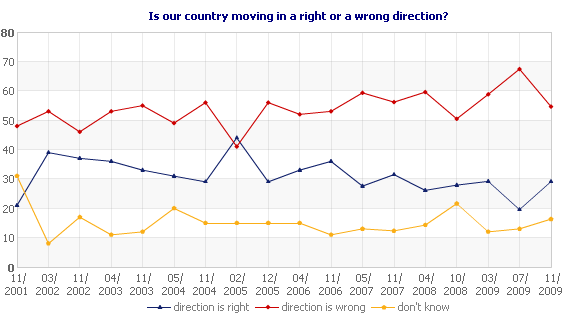
The perception of economic evolutions was bad enough during the PCRM ruling. Thus, the percent of those not so content with the economic situation has increased from about 10 percent in 2001 up to over 25 percent in 2009, while the percent of those rather content has dropped from 20 percent down to below 10 percent during the PCRM rule. Last BOP carried out in November 2009 indicates better perceptions of people in this area, too.
Table 2. To what extent are you content with the present economic situation in Moldova?
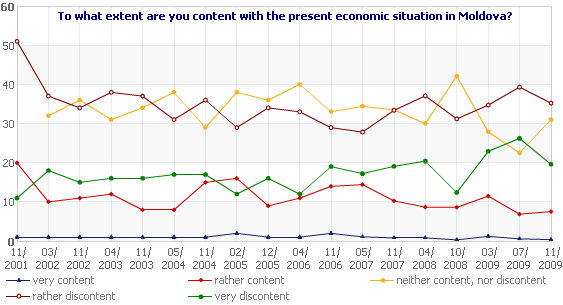
Responses to the general question about economic condition correlate relatively well with those related to the present economic situation compared to the one of a year ago. In particular, the number of those who perceived the economic situation worse than the precedent year was generally higher. The number of respondents who believed that the economic situation was better at the end of the PCRM ruling than the precedent year has dropped by about 20 percent, compared to the year when the PCRM took over the authority and respectively the percent of those who considered the contrary has increased to an equal extent.
Table 3. How do you assess the economic situation in the Republic of Moldova compared to a year ago?
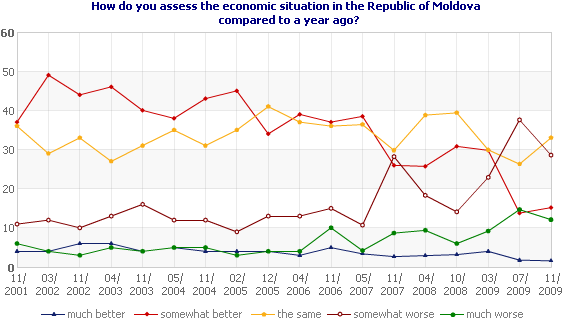
Expectations for next year revealed that the percent of optimists has generally declined by approximately 15 percent, while that of pessimists increased by about 20 percent. Again, it is worth noting that after AIE was elected to rule the country the level of optimism regarding the economic situation as compared with the last year and expectations regarding the next year are on the rise.
Table 4. How will the economic situation in the Republic of Moldova be in a year?
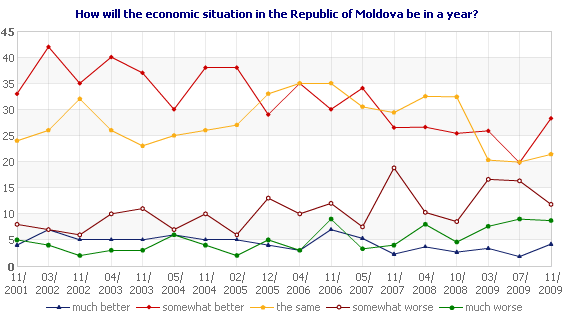
Individual perceptions related to incomes and concerns
Objectively, the extreme poverty rate had decreased much during the PCRM governing. At the level of individual perceptions the percent of respondents who earned not enough at least to cover their basic needs has dropped by approximately 20 percent, while the percent of those who earned enough just to cover their basic needs has increased by about 10 percent. The percent of those who earn enough to have a decent living has also increased by about 10 percent. The percent of wealthy people is similar to that during the PCRM ruling, within the margin of error.
Table 5. How do you assess the present income of your family?
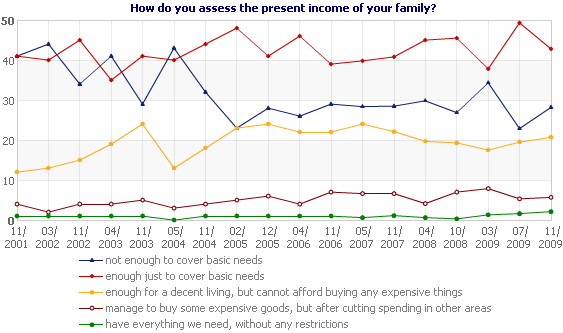
These findings reveal that expectations regarding economic evolutions in the country were much higher and were not met, despite the improvement of people’s individual material condition during the PCRM governing. That’s why the concern about poverty dominated during the PCRM ruling. In general, prices, children’s future and unemployment were constantly following poverty in the top of citizens’ concerns after the first mandate of PCRM. A success of PCRM in the ruling period clearly remarked by BOP was the decline on concerns about crimes.
Table 6. What are you most concerned about at present?
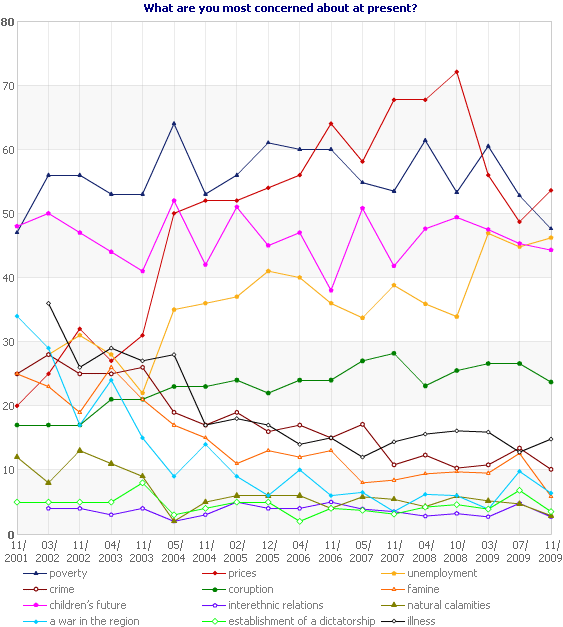
Suggestions for authorities
BOP findings reveal that the tasks regarded as of utmost importance for the Republic of Moldova did not change during the PCRM governance: developing the economy, strengthening the order, combating the corruption, improving the education, ensuring peace and understanding among people. However, the intensity of pressures from these tasks has dropped much. These evolutions may have two reasons. First, the intensity would have declined after the resolution of problems in the areas concerned; second, the social optimism assessed above has increased. Anyway, the response to the question below is a suggestion for authorities regarding people’ expectations from governors.
Table 7. Which issues do you consider as prior now for the Republic of Moldova?
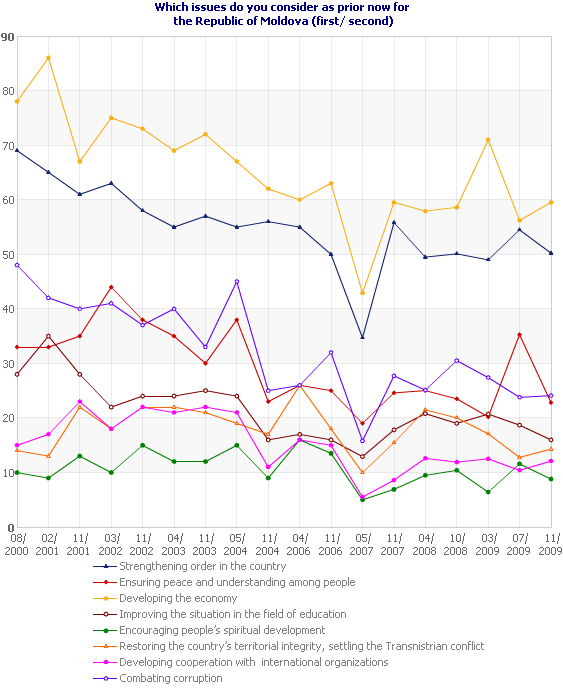
Responses to the question about measures that should be undertaken to improve the social-economic situation in the country could also be suggestions for authorities: improving the law enforcement tools, developing the industry, supporting the small business, encouraging investments etc. It is worth noting than citizens’ perceptions did not change in this area, too, for many years.
Table 8. What measures should be undertaken to improve the social-economic situation in Moldova?
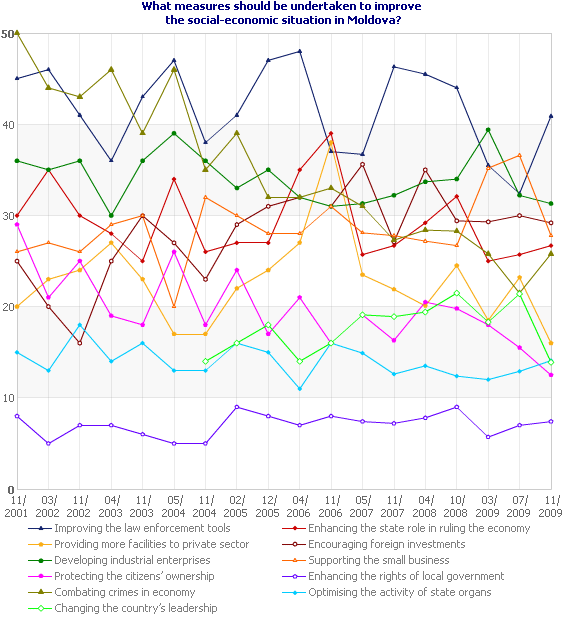
Trust in public and private institutions
Shortly after the PCRM succeeded to the power in 2001 the trust in public institutions has increased much, after being very low before. Thereby, after the first year of PCRM rule, the trust in President increased by more than 40 percent, in Parliament by over 30 percent, in Government by about 30 percent, and in local government by approximately 20 percent. However, the trust in courts and police did not actually increase during the PCRM governance. But by the end of the second PCRM mandate the confidence rating of President dropped by about 20 percent, compared to 2002, and the trust in Parliament and Government decreased by approximately 10–15 percent. On the other hand, the trust in all public institutions, except for the Presidency which is ruled by an interim chief of state has increased after the July 29, 2009 early parliamentary elections and takeover of governance by AIE. The clear growth of trust in political parties is probably linked to the fact that they were main protagonists of the “change” in 2009 and party leaders ran key public offices.
Table 9. To what extent do you trust?..
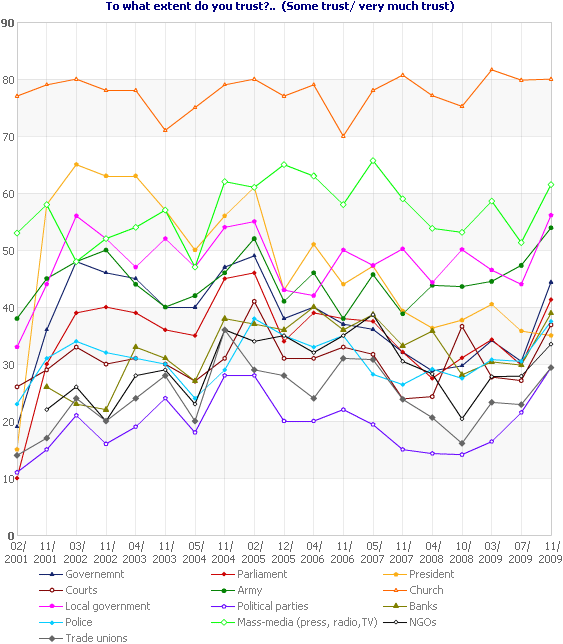
The table below does reveal that the trust in parties which were in opposition until summer 2009 increased much than the PCRM rating dropped, and this confirms the rise of the trust in parties. It is worth noting the rise of trust in the Democratic Party of Moldova (PDM) and Liberal Democratic Party of Moldova (PLDM). The trends revealed by the last two BOP measurements confirm that these two parties have a great political future in Moldova. One may suppose that PDM will likely fuel its rating on account of former PCRM supporters, while PLDM will attract supporters of lots of democratic parties which have a low ratings, as well as on account of coalition partners — Liberal Party (PL) and Moldova Noastra Alliance (AMN). At the same time, it is worth mentioning that the latest BOP revealed the lowest rating for PCRM, equivalent to the one recorded before the 2007 local elections.
Table 10. To what extent do you trust in the following political parties?
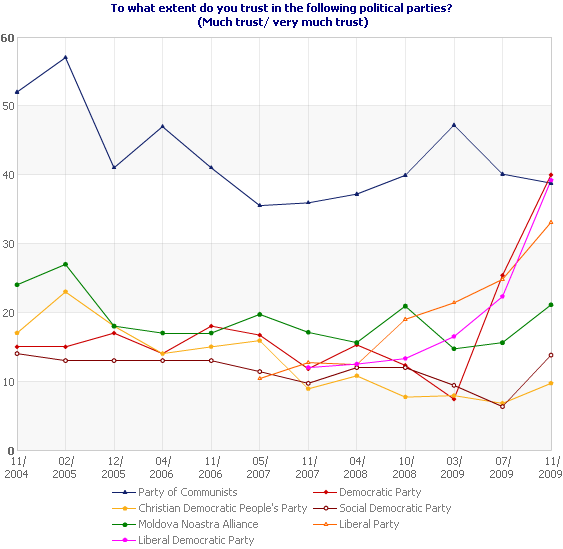
Suppositions made above are based on responses to the question about vote intentions in case of parliamentary elections. Plans to vote for PCRM, as well as for AMN are constantly on the decline, while the number of people willing to vote for PL is somewhat stable.
Table 11. What party would you vote for, if legislative elections were held in the Republic of Moldova next Sunday?
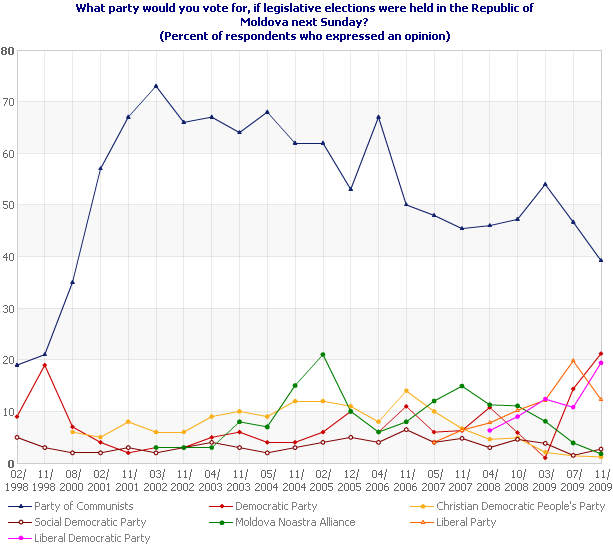
Trust in political leaders
Surveys reveal that the trust in party leaders is the guarantee of electoral success of the parties they head. In this respect, BOP reveals that after the first year of governing when he achieved the highest confidence rating, the rating of PCRM leader Vladimir Voronin was on the decline, down to over 30 percent by the end of the second mandate of PCRM. Since the rating of Vladimir Voronin keeps tending to fall down, and this fact correlates with the decline of the party’s rating, one may say that plans of PCRM to revenge are somehow hazardous.
Table 12. To what extent do you trust in the following political personalities?
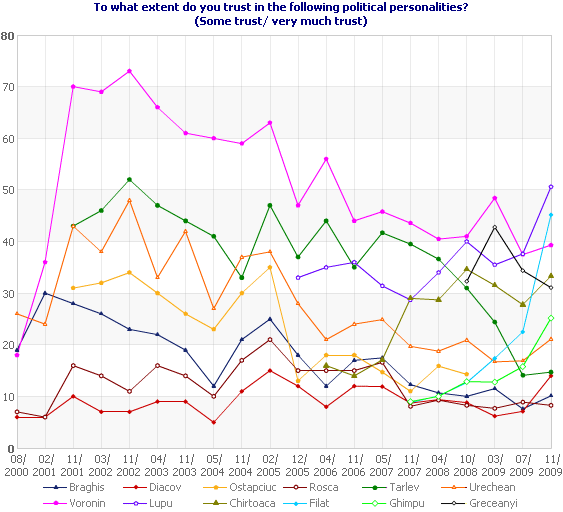
The most important indicator of the political and party leaders’ potential is to be mentioned in responses to the open question on people’s trust. The table below reveals very clear the evolution of this rating for PCRM leader Vladimir Voronin. Given the correlation of this rating with electoral results of the party, one may also assess the effects of the work of the PCRM-controlled media holding after the 2007 local elections, which the PCRM lost to opposition forces.
Table 13. Which is the political personality you trust in the most?
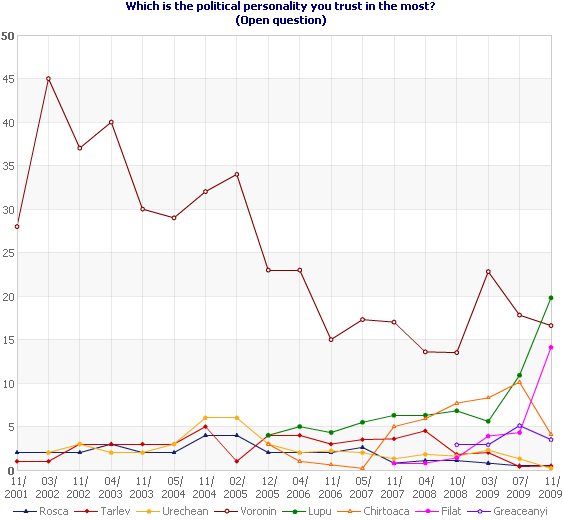
The strong rise of confidence ratings of PDM and PLDM leaders Marian Lupu and Vlad Filat reconfirms that the parties they lead have a much stronger potential than AIE partners. As well, BOP reveals that actions by PL leaders impress less than those taken by PLDM leaders.
Relations with foreign partners of the Republic of Moldova
Establishing good relations with neighbours and main international partners is a strategic goal for a small country with an open economy and a low potential. The way the citizens felt these relations reveals the conduct of the PCRM governance in terms of foreign relations. Thereby, while relations with the United States, European Union and Ukraine were perceived as being at a relatively constant level, the relations with Russia and Romania faced very dangerous breakdowns. The breakdown of relationship with Russia cost the Republic of Moldova the collapse of wine industry and all emerging consequences. After such relations with Russia during the PCRM rule, this party would unlikely regain the quasi total support of the Russian-speaking electorate, which is pretty heavy. Therefore, one should not be surprised by appearance of new projects aimed to assimilate some segments of the PCRM electorate. Even more, the loss of administrative levers will not allow the PCRM any longer to bar projects such as “Russia’s Friends in Moldova” in an arbitrary manner. This is one more argument that the locking of presidential elections by PCRM in an effort to revenge at early parliamentary elections in 2010 is a very expensive political adventure for the Republic of Moldova in general and perhaps for the PCRM in particular.
Table 14. How do you assess the present relations of the Republic of Moldova with the following countries?
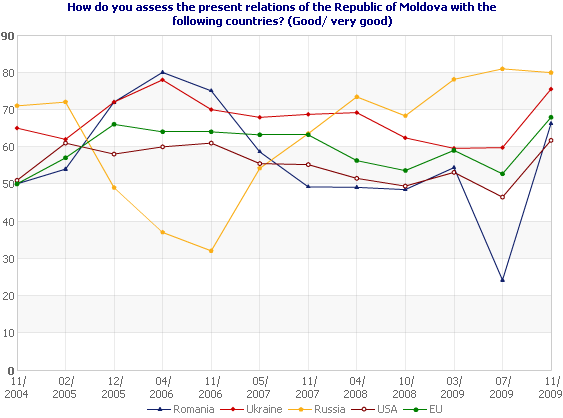
Conclusions
- Of course, almost all social-economic indicators had improved during the PCRM governance, except for 2009. However, people expected more than done, and the constant decline of optimism during the PCRM rule is a very clear proof in this regard. In general, the great rise of remittances — about 20 fold — in the eight years proves that people chose to go it alone, rather than to stake on PCRM authorities;
- The change on political scene in 2009 had a distinct social-political component. In this respect, BOP reveals that the takeover of the rule by AIE is followed by a perceptible rise of optimism regarding a better social-political and economic development of the Republic of Moldova. However, AIE members shall not forget that the trust may fall down and trends may reverse quickly in conditions of economic crisis and political incertitude. In addition, the PCRM constantly urges the AIE components to fulfil their electoral promises, setting aside the social-economic inheritance it has left and forgot that it indicated the term of a complete mandate to fulfil own promises when it was in the AIE shoes.
- The new configuration on Moldovan political scene has an immense potential to ensure predictable policies on social-economic sector and foreign relations for several electoral cycles ahead. BOP reveals that two parties with a concrete political turnover which are capable to attract support from adjacent parties on political scene have built their ground on centre-right and centre-left wings. Using this potential equally depends on performance of PLDM and PDM. In all likelihood, PCRM and PL will flank influent political elements with a declining rating from the left and the right wings;
- Before early parliamentary elections the public visibility of Premier Vlad Filat, leader of PLDM, promises to climb him to the rating of the most credible politician in Moldova and bring appropriate consequences to his party. In order to develop an efficient multi-party system, PDM leader Marian Lupu will have to “invent” hot public events or seize the excess of zeal of PLDM partisans. On the other hand, the PL deputy chairman and electoral engine of this part, Dorin Chirtoaca, will have to take actions in order to prevent the narrowing of his electoral segment tagged just on the ethic-linguistic dimension;
- The PCRM boycott of presidential elections with the purpose to revenge at eventual early elections in 2010 has all features of a political adventure with unpredictable consequences both for the Republic of Moldova and for the party concerned. The worst side of the revenge plan is that it produces precaution from the ruling AIE, reactions capable to be equivalent to the behaviour of the ruling PCRM that means contrary to authentic democratic standards.


